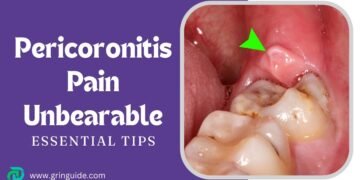Table of Contents
Gingivitis is a common gum disease that affects many people worldwide. It is characterized by inflammation of the gums, which can lead to various oral health problems if left untreated. The good news is that gingivitis can be treated and even reversed with proper care and oral hygiene practices.
In this article, we will explore the causes, symptoms, and treatment options for gingivitis.
Causes
Gingivitis is primarily caused by poor oral hygiene. When plaque, a sticky film of bacteria, builds up on the teeth and gums, it can irritate and inflame the gum tissue. Other factors that can contribute to the development of gingivitis include:
- Smoking or tobacco use
- Hormonal changes during pregnancy
- Diabetes
- Weakened immune system
- Certain medications
- Genetic predisposition
Symptoms
The early stages of gingivitis may not cause any noticeable symptoms, which is why regular dental check-ups are essential for early detection. However, as the condition progresses, the following symptoms may occur:
- Red, swollen, or tender gums
- Bleeding gums, especially during brushing or flossing
- Bad breath (Halitosis)
- Receding gums
- Changes in the way your teeth fit together when you bite (Loose or shifting teeth).
Treatment – Getting Rid of Gingivitis
The good news is that gingivitis can be treated and even reversed with proper oral hygiene practices. Here are some steps you can take to get rid of gum disease:
1. Practice Good Oral Hygiene
The foundation of gingivitis treatment is maintaining good oral hygiene. This includes:
- Brushing your teeth at least twice a day with a soft-bristled toothbrush and fluoride toothpaste. Be sure to brush along the gumline and all surfaces of your teeth.
- Flossing and using interdental brush daily to remove plaque and food particles from between your teeth and along the gumline.
- Using an antimicrobial mouthwash to help kill bacteria and reduce plaque.
It’s important to note that brushing too vigorously or using a toothbrush with hard bristles can actually irritate the gums and worsen gingivitis. Be gentle yet thorough when brushing your teeth.
2. Visit Your Dentist Regularly
Regular dental check-ups and professional cleanings are essential for treating and preventing gum disease. Your dentist will be able to remove any plaque or tartar that has built up on your teeth and provide guidance on proper oral hygiene techniques.
During your dental visit, your dentist may also recommend additional treatments, such as scaling and root planing, to remove plaque and tartar from below the gumline and smooth the roots of your teeth to prevent bacteria from reattaching.
In some cases, your dentist may prescribe antibiotics or antimicrobial mouth rinses to help control the infection and reduce inflammation.
3. Make Lifestyle Changes
In addition to good oral hygiene practices, certain lifestyle changes can help in getting rid of gingivitis:
- Avoid tobacco products, as they can worsen gum disease and delay healing.
- Eat a balanced diet that is rich in fruits and vegetables and low in sugary and processed foods.
- Manage stress, as stress can weaken the immune system and make it harder for your body to fight off infections.

4. Use Natural Remedies
While natural remedies cannot replace professional dental care, they can be used as adjuncts to help reduce inflammation and promote gum health. Some natural remedies that may be beneficial for gum disease include:
- Rinsing with warm saltwater: Dissolve half a teaspoon of salt in a cup of warm water and rinse your mouth with it for 30 seconds. This can help reduce inflammation and kill bacteria.
- Applying aloe vera gel: Aloe vera has anti-inflammatory properties and can soothe irritated gums. Apply a small amount of aloe vera gel to the affected areas.
- Using tea tree oil: Dilute a few drops of tea tree oil in water and use it as a mouthwash. Tea tree oil has antimicrobial properties that can help fight bacteria.
It’s important to note that natural remedies should be used in conjunction with professional dental care and not as a substitute for it.
If you experience any of these symptoms, it is important to consult a dentist for a proper diagnosis and treatment plan.
Preventing Gingivitis
Preventing methods involves maintaining good oral hygiene practices. Here are some tips to help prevent the development of gum disease:
- Brush your teeth at least twice a day with a fluoride toothpaste.
- Floss daily to remove plaque from between your teeth.
- Use an antimicrobial mouthwash to help reduce bacteria in the mouth.
- Avoid smoking or tobacco use.
- Eat a balanced diet and limit sugary snacks and beverages.
- Visit your dentist regularly for check-ups and cleanings.
By following these preventive measures, you can significantly reduce your risk of developing gum disease and other gum diseases.
Can Gingivitis Be Cured?
The good news is that gingivitis can be cured, especially if it is detected early and proper treatment is administered. With the right oral hygiene practices, regular dental visits, and lifestyle changes, the inflammation and symptoms of gingivitis can be reversed.
However, it’s important to note that once you have had gum disease, you are at a higher risk of developing it again in the future. This is why it’s crucial to maintain good oral hygiene habits and continue to visit your dentist regularly even after your gum disease has been cured.
It is important to note that gingivitis can progress to a more severe form of gum disease called periodontitis if left untreated. Periodontitis can cause irreversible damage to the gums and bone supporting the teeth, leading to tooth loss. Therefore, early intervention and proper treatment are crucial in managing gingivitis.
What does stage 1 gingivitis look like?
Stage 1 gingivitis is the earliest form of gum disease, also known as periodontal disease. It occurs when plaque and bacteria build up on your teeth, leading to irritation, redness, swelling, and bleeding of the gingiva (the part of your gum around the base of your teeth).
Here are the signs and symptoms of stage 1 gingivitis:
- Tender Gums: You may experience tenderness in your gums.
- Bad Breath: Persistent bad breath that doesn’t go away even after brushing can be indicative of gum disease.
- Bleeding Gum: Gum that bleed easily when you brush, or floss is a common sign of gingivitis.
- Swollen or Puffy Gums: Your gums may appear swollen or puffy.
- Bright Red or Dark Red Gums: gum disease can cause your gums to become red or even darker than usual.
- Sensitivity to Hot or Cold Foods: gum disease may make your gums more sensitive to temperature changes.
- Pain When Chewing: Some individuals with gum disease may feel discomfort or pain while chewing food.
If you notice any of these symptoms, it’s essential to seek professional dental care promptly. Regular dental cleanings and improved oral hygiene at home can help manage gingivitis effectively.
In Conclusion
Gingivitis is a common gum disease that can be prevented and treated with proper oral hygiene practices and regular dental check-ups. If you notice any signs or symptoms of gum disease, it is important to seek professional dental care to prevent the condition from progressing to a more severe form of gum disease. Remember, prevention is key when it comes to maintaining good oral health.
FAQs
-
What is Gingivitis?
Gingivitis is the earliest stage of gum disease, also known as periodontal disease. It’s characterized by inflammation of the gums, leading to redness, swelling, and bleeding around the base of your teeth.
-
What Causes Gingivitis?
The primary cause is plaque—a sticky, colorless film of bacteria that forms on your teeth.
-
How is Gingivitis Treated?
Treatment includes professional dental cleaning to remove plaque and tartar, followed by consistent oral care at home.
Sources:








